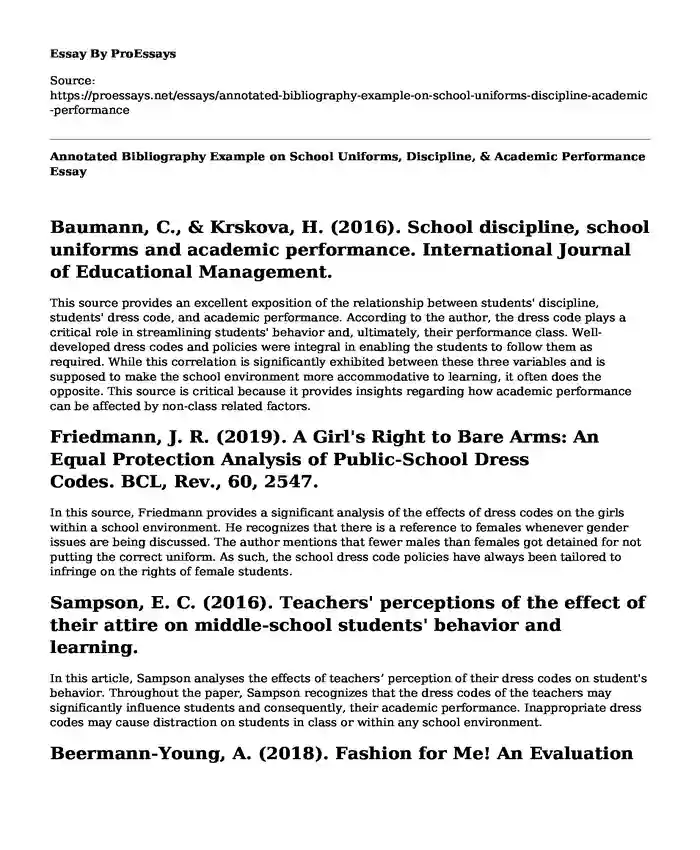Baumann, C., & Krskova, H. (2016). School discipline, school uniforms and academic performance. International Journal of Educational Management.
This source provides an excellent exposition of the relationship between students' discipline, students' dress code, and academic performance. According to the author, the dress code plays a critical role in streamlining students' behavior and, ultimately, their performance class. Well-developed dress codes and policies were integral in enabling the students to follow them as required. While this correlation is significantly exhibited between these three variables and is supposed to make the school environment more accommodative to learning, it often does the opposite. This source is critical because it provides insights regarding how academic performance can be affected by non-class related factors.
Friedmann, J. R. (2019). A Girl's Right to Bare Arms: An Equal Protection Analysis of Public-School Dress Codes. BCL, Rev., 60, 2547.
In this source, Friedmann provides a significant analysis of the effects of dress codes on the girls within a school environment. He recognizes that there is a reference to females whenever gender issues are being discussed. The author mentions that fewer males than females got detained for not putting the correct uniform. As such, the school dress code policies have always been tailored to infringe on the rights of female students.
Sampson, E. C. (2016). Teachers' perceptions of the effect of their attire on middle-school students' behavior and learning.
In this article, Sampson analyses the effects of teachers’ perception of their dress codes on student's behavior. Throughout the paper, Sampson recognizes that the dress codes of the teachers may significantly influence students and consequently, their academic performance. Inappropriate dress codes may cause distraction on students in class or within any school environment.
Beermann-Young, A. (2018). Fashion for Me! An Evaluation of Student Fashion Choices and School Dress Code Policies (Doctoral dissertation, San Diego State University).
Beermann-Young provides an exposition of the impacts that student choices for fashion have on the dress code policies and their behaviors within the school. According to Beermann, allowing students to choose what to wear in school leads to some unethical behavior, especially when they began putting on inappropriately. This may cause a severe distraction within the classroom environment. Clothing enhances distraction as some attires will show-off someone's body leading to reduced performance because of low-class concentration.
Kees, A. G. (2017). The Impact of School Dress Codes on the Quality of Student Life at a Selected High School (Doctoral dissertation).
Kees provides a significant discussion regarding the effects of dress codes on the quality of student’s life within the school environment. According to the author, most schools follow a common motto or policies that help it inculcate discipline amongst students, even though they have varied disciplines. As such, the dress code has a tremendous impact on the quality of life students are subjected to within the school environment. The right dress code will inculcate good students’ behavior and vice versa.
Lattimore, K. (2017). When Black hair violates the dress code. National Public Radio: Washington, DC, USA.
Lattimore discusses the relationship between dress code and race. Broadly, he explains that the dress code policies have been mainly implemented in most schools in the US to infringe on the rights of the black students, who mostly form the minority groups in most parts. As such, a black student is likely to receive harsh punishments whenever they are found to have broken
Kawa, K. (2018). Are school uniforms suitable for students? New York, NY: Greenhaven Publishing LLC.
Broadly, Kawa discusses the significance of the school uniforms on students. He mentions that proper school dress code inculcates discipline and good behavior that can be translated into good academic performance. Additionally, it eliminates distractions that may emerge within the class.
Han, S. (2017). Corporal Punishment in Rural Schools: Student Problem Behaviours, Academic Outcomes, and School Safety Efforts. Singapore: Springer Singapore.
Hans analyzes the implementation of certain dress code policies as a mechanism of punishing certain groups of students. Broadly, it examines the various school-specific factors that include alternative discipline, school safety efforts, and problematic students' behavior.
Cite this page
Annotated Bibliography Example on School Uniforms, Discipline, & Academic Performance. (2023, Sep 10). Retrieved from https://proessays.net/essays/annotated-bibliography-example-on-school-uniforms-discipline-academic-performance
If you are the original author of this essay and no longer wish to have it published on the ProEssays website, please click below to request its removal:
- Brief Description of Unilever Essay
- The Theory of Extrinsic Motivation Paper Example
- Developmental Stages in Children Essay Example
- Essay Sample on Importance of Social Groups
- Perceptions: Our Daily Life's Impact on Us - Essay Sample
- Paper Example on Restorative Justice: An Overview of Programs and Benefits
- Free Personal Statement Sample on Pursuing an MBA







